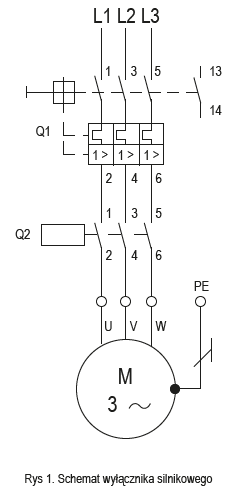Dobór wyłącznika silnikowego
Wyłącznik silnikowy
Moc silnika
Najczęściej wyłączniki silnikowe stosowane są do zabezpieczenia silników o małej mocy – do około 4kW. W wyjątkowych sytuacjach stosuje się także wyłączniki umożliwiające łączenie silników większych mocy.
Funkcje wyłącznika silnikowego
Nieodpowiednio pracujący silnik narażony jest na zniszczenie i może być przyczyną pożaru – koniecznym jest więc zabezpieczenie go (i całej instalacji) przed skutkami:
- zwarć (za błyskawiczne rozłączenie odpowiedzialny jest wyzwalacz elektromagnetyczny – czas zadziałania jest rzędu milisekund)
- zaniku faz zasilania (asymetrii fazowej)
- przeciążeń i zablokowanego rozruchu (odpowiedzialny za to jest wyzwalacz termiczny)
Dobór nastaw wyłącznika silnikowego
Wyłączniki silnikowe wyposażone są w pokrętło służące do ustawienia prądu rozłączenia – ustawia się go według prostego wzoru:
Inas = In * 1,1, gdzie
In - prąd znamionowy silnika
Inas - prąd nastawy wyłącznika
Na przykład do zabezpieczenia silnika o prądzie znamionowym 10A pokrętło powinno się nastawić na 11A (10*1,1).
Montaż wyłącznika silnikowego
Kluczową kwestią jest montaż wyłącznika zawsze przed stycznikiem – uchroni to stycznik przed skutkami ewentualnych zwarć.
 |
Pozostałe informacje
Istotną kwestią przy wyborze wyłącznika silnikowego jest także prąd zwarciowy. Parametr ten świadczy o maksymalnym prądzie, który może przepłynąć w trakcie zwarcia, nie uszkadzając trwale wyłącznika.
W instalacjach wykorzystujących wiele silników pracujących równolegle należy pamiętać, aby każdy z silników zabezpieczony był oddzielnym wyłącznikiem – zapobiegnie to awarii w razie, gdy jeden z silników będzie obciążony w większym stopniu od pozostałych.


